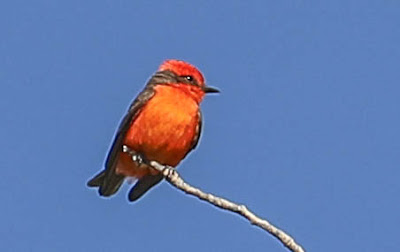I can recall previous sightings of the vermilion flycatcher: one at Organ Pipe Cactus NM many years ago when my boys were young and there were pools of water in Alamo Canyon; and a prior year at Big Morongo Preserve, but I'd never gotten a photo of one.
 |
| A male and two females from my visit on May 14. |
That all changed with two trips to Big Morongo Preserve in Yucca Valley on book-ended Saturdays. I got photos of vermilion flycatchers each Saturday.
 |
| A male from May 21. |
The male is spectacular with a bright red crown, chest and underparts and brownish wings and tails. The color varies through the range from vermilion to scarlet to orange and brownish black to black. Females are brownish above with white breast and reddish belly and undertail coverts.
The first description was based on specimens brought back by Charles Darwin on the second voyage of the Beagle. There are nine subspecies which are differentiated largely on the basis of the color and saturation of the male's plumage and the color and the amount of streaking of the female's plumage: (a) the nominate race is found in the Lima region of western Peru (P. o. obscurus); (b) P. o. mexicanus is found from southern Texas to central and southern Mexico and is the blackest; and (c) P. o. flammeus, found in the southwestern U.S. and northwestern Mexico, the subspecies I saw, has paler and slightly gray upperparts and underparts that are more orange. Other species are in northwestern and northern South America. North American populations are generally resident with migrations only at the edge of the range.
 |
| Purple is year round; orange is breeding; and blue is non-breeding. From Wikipedia. |
They catch their prey by flying.






WOW, what a beautiful bird. This is one where I really feel sorry for the female, which is pretty but can't hold a candle to that spectacular male.
ReplyDelete